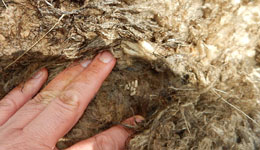Tip 1: preventing flystrike

Alt: Photo of a sheep's fleece being separated to show a flystrike wound.
This is the first in a series providing information on reducing losses from disease amongst your sheep flock.
Blowfly strike is a scourge of the sheep industry, and sheep owners should use multiple methods to prevent the unnecessary suffering and losses the disease causes.
Start by running a bloodline of sheep that have been selected to survive the flystrike challenge likely on your property, by sourcing sheep from a similar environment as your farms'. Then apply simple, proven selection methods to ensure that you only breed replacements from the most robust of the sheep you have.
There are easy-to-use visual scoring methods described at the FlyBoss website; of particular importance for Victorian flocks are those relating to dag and wrinkle scores. Within a relatively short period of time, a robust, flystrike resilient flock can be developed — one that requires less of the other management inputs described below, whilst still maintaining desirable fleece characteristics.
Short wool dries quicker than long wool, so shearing or crutching at the appropriate time can reduce the risk of flystrike. FlyBoss has a wonderful simulation tool that lets you model the effect on flystrike risk in your flock through management interventions. There are other reasons for selecting the timing of both shearing and crutching, but fly control should be an important part of the choice. Where the timing of shearing is inappropriate for flystrike control in your flock you must use other methods to control the disease.
The application of the long-acting preventative chemicals cyromazine, dicyclanil or ivermectin can have a significant impact on flystrike risk, whether applied before the flystrike season really commences, or during high risk periods. Whenever chemicals are used, owners should pay particular attention to the various withholding periods applicable. For flystrike these include the Meat Withholding Period, Wool Harvest Interval, and the Wool Rehandling Interval, to ensure that you can safely apply these chemicals when you do not impinge of these intervals.
Breech modification, when performed correctly, can reduce flystrike risk. Dock tails to the ideal length, which equates to reaching the tip of the vulva in ewe lambs. Pay attention to technique, and maintain clean, sharp equipment that is frequently disinfected. Mulesing with pain-relief (TriSolfen®) can also be used where the flock has not been selected for flystrike resilience, although genetic selection is a permanent solution to the problem. Whatever method of breech modification you employ, ensure that you declare it on your National Wool Declaration, to capture any market premiums that may be available.
Finally, promptly detect and treat any struck sheep. Doing so not only prevents the ongoing welfare issue for that sheep, but also reduces the number of flies present to strike other sheep. Remove all of the affected wool, apply an insecticide to the wound, sterilise the harvested wool, and mark the sheep for ongoing monitoring. In some instances, veterinary assistance can be sought.
For more information on managing flystrike visit: www.flyboss.com.au found at www.paraboss.com.au